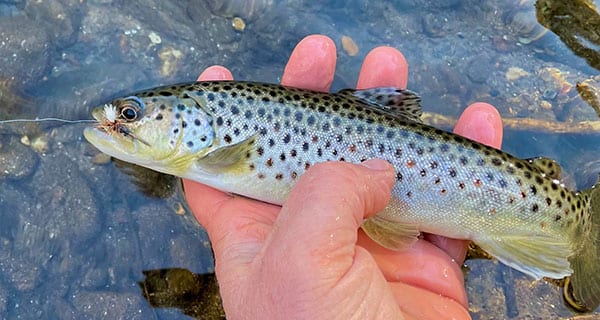Fly fishing for trout appeals to many anglers because challenges of the sport, from casting to hatch-matching, but those challenges can be intimidating to anglers who want to give the sport a try. We’re here to help! Let’s simplify one of the first challenges: your starter fly collection. For Southeastern trout, give this basic 12-compartment box of only a dozen fly patterns a try. A row of four dry flies, a row of four wets, and a row of four attractors will get you into fish in most cases. Let’s take a look at its contents.
Row 1 has four dry fly patterns to match adult insects riding the water’s surface. Try a parachute adams (dark mayfly), parachute light cahill (light mayfly), tan elk hair caddis, and a yellow stimulator (stonefly). For the first three patterns, buy 2-3 flies in each of these sizes: 14, 16, and 18. Stock the stimmies in sizes 14 and 16.
Row 2 holds your wet flies that resemble immature stream insects crawling on the bottom and drifting in the current. Stock up these four compartments with gold-ribbed hare’s ear nymphs (#14, 16), pheasant tail nymphs (#16, 18), sexy Walt’s worms (#12, 14) and brown Pat’s rubberlegs (#10). The first two patterns imitate a wide variety of stream bugs, while the Walt’s will cover caddis larvae and the Pat’s resembles stonefly nymphs.
Row 3 contains my four favorite attractor patterns. The first is the best fly ever created: the black woolly bugger (#10). You can’t fish it wrong, so try dead-drifting, swinging it in the current, and then stripping it in like a fleeing baitfish. Next is a bead-head prince nymph (#14), which is both flashy and buggy at the same time. It’s a great searching nymph when drifting deep or fast water. Third is a peach glo-bug (#12), which imitates fish eggs and Purina pellets. Eggs are hot for wild and Delayed Harvest trout during fish spawning season (December through March) and for hungry stockers in spring when your local wildlife resources division plunks them into your favorite streams. The last pattern matches the spring/summer “thunderstorm hatch.” It’s a red squirmy worm (#12). Storms wash in earthworms, discolor the water, and put trout on the feed. Hint: use heavier line (tippet) and carry a big net!
This basic box of 12 patterns should get you started in the trout game. Fish them well and you’ll be hooked on the sport. Soon, you’ll look like me, the “Michelin Man” with a vest bloated by too many fly boxes. But know that, despite toting around half a fly shop, I’ll usually knot one of my top dozen to the end of my line. Call 706-878-3083 or visit our fly shop if we can help you further. Also, give the awesome Orvis Learning Center a look (https://howtoflyfish.orvis.com/).
You can find Jeff Durniak at Unicoi Outfitters. Stop in or call the Helen shop at (706-878-3083) or our Clarkesville store on the square (706-754-0203) if we can help you further. After all, we are pretty darn good trouting caddies!
